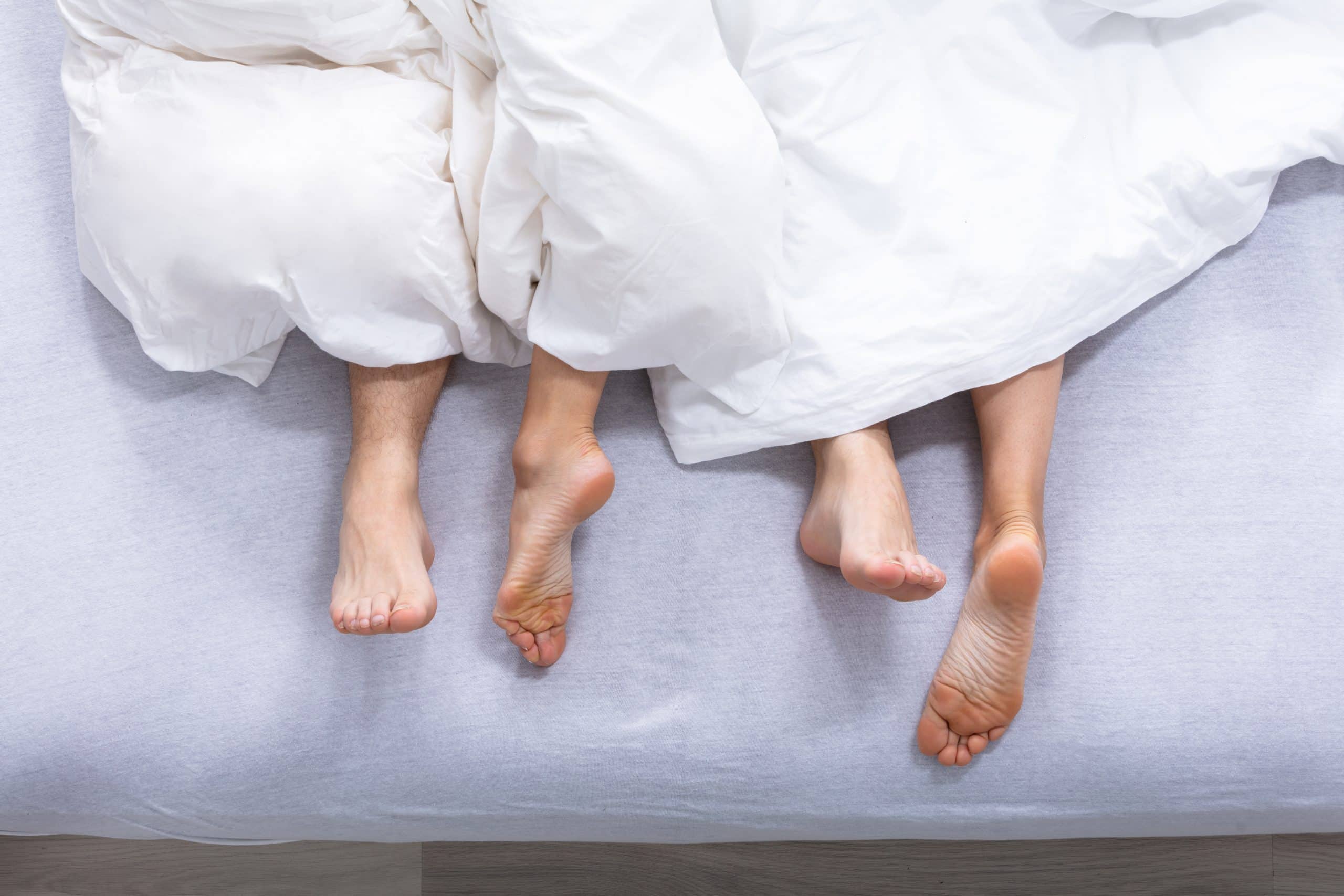The phrase “put your feet up” has the causal meaning of taking a break by sitting or reclining with one’s feet up. But did you know that there’s actual science behind the phrase? Turns out, elevating your legs while you sleep can offer some major health benefits. Aside from the obvious relief you’ll feel after spending a long day on your feet, sleeping with your legs elevated can help ease symptoms of various conditions. Let’s explore the pros and cons of sleeping with legs elevated, as well as how to do it correctly.
Benefits of Sleeping With Legs Elevated
There are a few key reasons why you should consider sleeping this way:
It Can Improve Blood Flow
The principle of gravity dictates that blood flow is slower when your legs are below your heart. This is because blood has to work against gravity in order to reach your upper body.
It doesn’t help that modern lifestyles involve sitting or standing for long periods of time, which further contributes to poor blood circulation in the legs.
Sleeping with your legs elevated helps reduce pooling of blood in the lower limbs, which in turn can improve circulation. This is especially beneficial for people who have circulatory problems like varicose veins or deep vein thrombosis (1).
To take full advantage of this benefit, aim to elevate your legs above your heart.
It Can Reduce Swelling
Swelling in the lower limbs is a common problem, especially among pregnant women and people who have just had surgery. This is usually caused by fluid retention—a condition that can be made worse by hot weather, standing for long periods of time, and eating a high-sodium diet (6).
Fluid retention is a problem, with the increased pressure in the veins causing inflammation and discomfort. Sleeping with your legs elevated helps reduce swelling by allowing gravity to pull the fluid away from the legs and back into circulation (6).
It Can Alleviate Pain
If you suffer from conditions like arthritis or muscle cramps, sleeping with your legs elevated can help reduce pain. This is because elevating the legs takes pressure off the joints, which in turn can lessen pain and inflammation (14).
Read More: Why Do My Muscles Tighten Up When I Sleep? (Causes & Solutions)
Lowers Pressure
Standing for long hours causes blood to pool in the veins of your lower limbs. This increases the pressure in the veins, which can lead to pain, inflammation, and varicose veins (5).
Sleeping with your legs up helps reduce this pressure by allowing gravity to pull the blood from your lower limbs back into circulation. This can ease pain and discomfort, as well as help prevent varicose veins (1).
It Can Help Prevent Leg Cramps
Leg cramps are often caused by overuse or dehydration, and can be extremely painful. Sleeping with your legs elevated can help prevent leg cramps by reducing the pressure on the muscles and joints. This in turn can help reduce pain and inflammation (8).
It Can Improve Your Spinal Alignment
Your spine has a natural curve that is designed to support your body. However, this curve can be thrown off balance by activities like slouching or sitting for long periods of time. This can lead to pain and discomfort in the lower back and legs (7).
Sleeping with your legs elevated helps maintain the natural curve of your spine, which in turn can improve your posture and alleviate pain (7).
It Can Help Reduce Fatigue
Lower back pain, restless legs, and poor circulation can all disrupt your sleep or make it difficult to fall asleep in the first place. This can lead to fatigue during the day.
Sleeping with your legs elevated can help improve circulation and alleviate pain, both of which guarantee a good night’s sleep (9). This in turn can help reduce fatigue during the day.
Lean and toned up body isn’t just a far-fetched fantasy. Check out the BetterMe app and watch it propel your weight loss journey into high gear!
Which Conditions Benefit From Sleeping With Legs Elevated?
Certain health conditions can benefit from sleeping with the legs elevated. These include:
Lymphedema
Damage to the lymphatic system can cause a buildup of fluid in the arms or legs, which can lead to swelling. Sleeping with the legs elevated can help reduce swelling (13).
Edema
This is a condition characterized by an abnormal accumulation of fluid in the body. It can cause swelling in the legs and feet. Sleeping with the legs elevated can help reduce swelling (6).
Chronic Venous Insufficiency
This is a condition in which the veins have difficulty circulating blood back to the heart. It can lead to pain, swelling, and inflammation in the legs (2). Sleeping with the legs elevated can help improve circulation and reduce symptoms.
Superficial Thrombophlebitis
This is a condition in which a blood clot forms in a vein just under the skin. It can cause pain, inflammation, and swelling. Sleeping with the legs up can help reduce symptoms (11).
Deep Vein Thrombosis
This is a condition in which a blood clot forms in a deep vein, usually in the leg. It can cause pain, swelling, and inflammation. Sleeping with the legs elevated can help reduce symptoms (1).
Varicose Veins
These are enlarged veins that can be painful and cause swelling. Sleeping with the legs elevated can help reduce symptoms (15).
Spider Veins
These are small, twisted veins that are visible under the skin. They are usually harmless but can be uncomfortable. Sleeping with the legs elevated can help reduce symptoms (10).
Cellulitis
This is a skin infection that can cause redness, swelling, and pain. Sleeping with the legs elevated can help reduce symptoms (3).
Pregnancy
Hormonal changes, weight gain, and fluid retention can cause swelling in the legs during pregnancy. Sleeping with the legs elevated can help reduce symptoms (12).
Post-Surgery
Elevating the legs after surgery can help reduce pain and swelling (4).
Read More: Why Does Milk Make You Sleepy? Learn All The Facts!
How To Sleep With Legs Elevated
There are a few different ways you can sleep with your legs elevated:
- Use pillows to prop up your legs. Place pillows under your knees, thighs, or calves.
- Place a foam wedge under your mattress. This will elevate your legs while you sleep.
- Sleep in a reclining position. You can use a reclining chair or bed.
- Use a leg elevation device. These devices are specifically designed to elevate the legs while you sleep.
Tips For Sleeping With Legs Elevated
There are a few things you can do to make sure you get the most out of sleeping with your legs elevated:
- Try to sleep for at least 7-8 hours each night.
- Elevate your legs for at least 30 minutes before going to bed.
- Wear loose, comfortable clothing. Tight clothing can constrict blood flow.
- Drink plenty of fluids during the day to help reduce swelling.
- Exercise regularly to improve circulation.
Sleeping with your legs up can be a helpful way to reduce pain, swelling, and inflammation. Be sure to talk to your doctor before trying this method to make sure it’s safe for you.
Looking for a way to break the vicious cycle of weight loss and tone up all the jiggly parts? Watch the extra pounds fly off and your muscles firm up with the BetterMe app!
The Bottom Line
Sleeping with your legs elevated can be a helpful way to reduce pain, swelling, and inflammation. Be sure to talk to your doctor before trying this method to make sure it’s safe for you.
DISCLAIMER:
This article is intended for general informational purposes only and does not address individual circumstances. It is not a substitute for professional advice or help and should not be relied on to make decisions of any kind. Any action you take upon the information presented in this article is strictly at your own risk and responsibility!
SOURCES:
- Avoiding the consequences of deep vein thrombosis (1998, nih.gov)
- Chronic Venous Insufficiency: prevalence and effect of compression stockings (2014, nih.gov)
- Diagnosis and management of cellulitis (2018, nih.gov)
- Effect of Leg Elevation Height on Reduced Swelling of Patients of Postoperative Acute Ankle Fractures (2020, researchgate.net)
- Evidence of Health Risks Associated with Prolonged Standing at Work and Intervention Effectiveness (2015, nih.gov)
- Fluid retention (oedema) (2022, betterhealth.vic.gov.au)
- Good Sleeping Posture Helps Your Back (n.d., rochester.edu)
- Nocturnal leg cramps: Prevalence and associations with demographics, sleep disturbance symptoms, medical conditions, and cardiometabolic risk factors (2017, nih.gov)
- Posture and Time Arrangement Influence Shank Circumference Reduction When Performing Leg Raising Exercise (2020, nih.gov)
- Spider Veins (2022, nih.gov)
- Superficial thrombophlebitis (n.d., mtsinai.org)
- Survey of maternal sleep practices in late pregnancy in a multi-ethnic sample in South Auckland, New Zealand (2017, nih.gov)
- The Effect of Lymphoedema Exercises and Foot Elevation on the Quality of Life of Patients with Elephantiasis (2020, nih.gov)
- Tips to Ease Joint Pain (n.d., arthritis.org)
- Varicose veins (n.d., mayoclinic.org)













